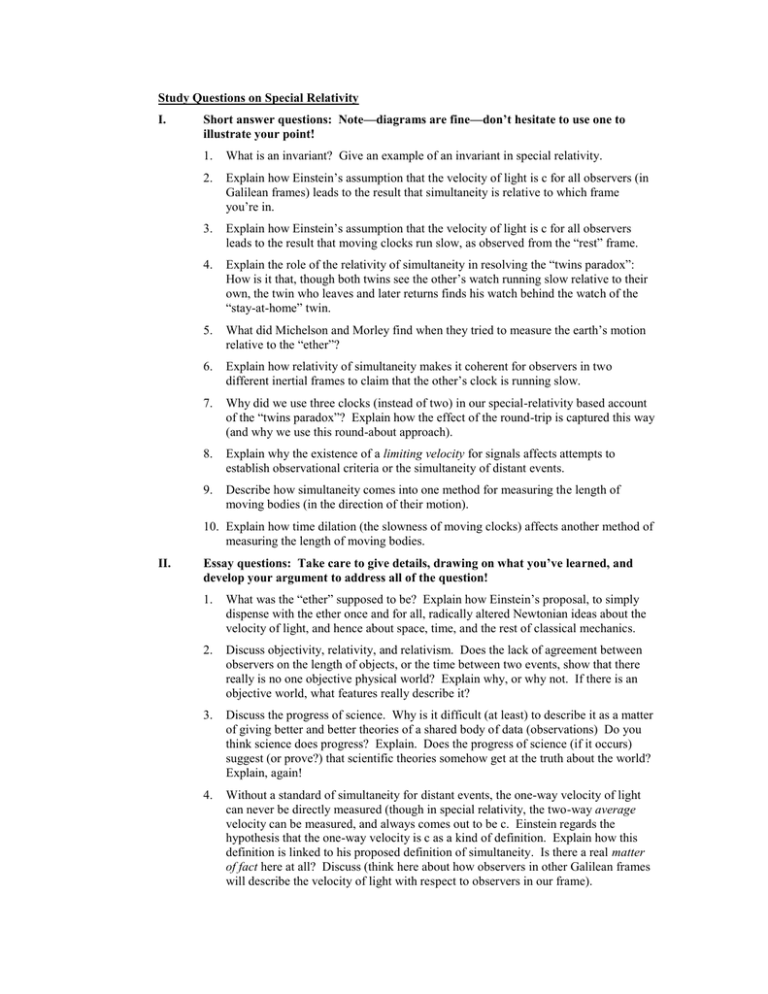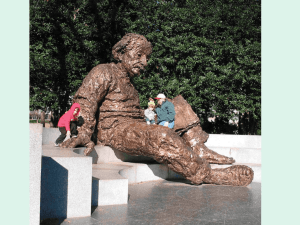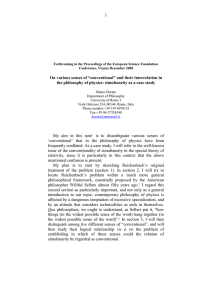Study Questions on Special Relativity I.
advertisement

Study Questions on Special Relativity I. Short answer questions: Note—diagrams are fine—don’t hesitate to use one to illustrate your point! 1. What is an invariant? Give an example of an invariant in special relativity. 2. Explain how Einstein’s assumption that the velocity of light is c for all observers (in Galilean frames) leads to the result that simultaneity is relative to which frame you’re in. 3. Explain how Einstein’s assumption that the velocity of light is c for all observers leads to the result that moving clocks run slow, as observed from the “rest” frame. 4. Explain the role of the relativity of simultaneity in resolving the “twins paradox”: How is it that, though both twins see the other’s watch running slow relative to their own, the twin who leaves and later returns finds his watch behind the watch of the “stay-at-home” twin. 5. What did Michelson and Morley find when they tried to measure the earth’s motion relative to the “ether”? 6. Explain how relativity of simultaneity makes it coherent for observers in two different inertial frames to claim that the other’s clock is running slow. 7. Why did we use three clocks (instead of two) in our special-relativity based account of the “twins paradox”? Explain how the effect of the round-trip is captured this way (and why we use this round-about approach). 8. Explain why the existence of a limiting velocity for signals affects attempts to establish observational criteria or the simultaneity of distant events. 9. Describe how simultaneity comes into one method for measuring the length of moving bodies (in the direction of their motion). 10. Explain how time dilation (the slowness of moving clocks) affects another method of measuring the length of moving bodies. II. Essay questions: Take care to give details, drawing on what you’ve learned, and develop your argument to address all of the question! 1. What was the “ether” supposed to be? Explain how Einstein’s proposal, to simply dispense with the ether once and for all, radically altered Newtonian ideas about the velocity of light, and hence about space, time, and the rest of classical mechanics. 2. Discuss objectivity, relativity, and relativism. Does the lack of agreement between observers on the length of objects, or the time between two events, show that there really is no one objective physical world? Explain why, or why not. If there is an objective world, what features really describe it? 3. Discuss the progress of science. Why is it difficult (at least) to describe it as a matter of giving better and better theories of a shared body of data (observations) Do you think science does progress? Explain. Does the progress of science (if it occurs) suggest (or prove?) that scientific theories somehow get at the truth about the world? Explain, again! 4. Without a standard of simultaneity for distant events, the one-way velocity of light can never be directly measured (though in special relativity, the two-way average velocity can be measured, and always comes out to be c. Einstein regards the hypothesis that the one-way velocity is c as a kind of definition. Explain how this definition is linked to his proposed definition of simultaneity. Is there a real matter of fact here at all? Discuss (think here about how observers in other Galilean frames will describe the velocity of light with respect to observers in our frame).



